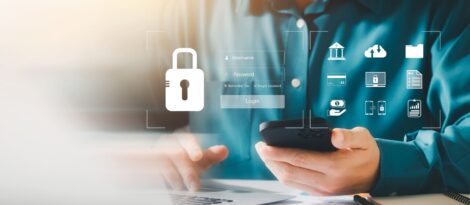Many of our customers are becoming increasingly aware of financial cybersecurity risks, from phishing scams to online credit card fraud. However, check fraud is also on the rise, with scammers utilizing new technology to attempt to deceive banking customers.
In this guide, we’ll provide you details on how to spot instances of check forgeries and scams, as well as practical tips for both check fraud protection and check fraud prevention. Keep reading to learn how you can avoid check fraud and keep your finances secure.
What is Check Fraud?
Check fraud is a form of financial fraud where an individual manipulates or misuses checks for personal gain. Fraudsters employ various techniques to deceive others and exploit weaknesses in the check processing system, aiming to obtain funds or other valuable assets dishonestly.
Unfortunately, check fraud is not only fairly common, it’s also on the rise. In fact, both check fraud and mail theft (often associated with check fraud) doubled between 2021 and 2022.
The US Post Office has been plagued with attacks on postal delivery people, resulting in stolen mail and stolen keys to USPS drop boxes. This has created an influx of check fraud throughout the country, including some of our account holders. It is difficult to detect until the account owner comes forward with a dispute over a check. Typically, they have mailed out a payment that was intercepted somewhere and never reached its destination. The check is then altered to pay someone else, or is scanned into a computer to produce multiple new checks with the scanned signature. If someone is victim to this kind of fraud, the USPS would like to know about it. You can contact them at 1-877-876-2455 or at https://www.uspis.gov/report to report the incident.
While banks take strong measures to help keep their customers’ funds safe, understanding check fraud is crucial for individuals, businesses, and financial institutions to protect themselves.
Types of Check Fraud
While there are many variations on how criminals can use checks to defraud their victims, most types of check fraud fall into two main categories: counterfeiting and forgery.
Counterfeit Checks
Counterfeit checks are fraudulent checks that are created to resemble genuine checks issued by legitimate entities. Criminals may try to pass off a counterfeit check as a legitimate check for payment, making them especially problematic for businesses who do business with clients across the country or overseas.
Fake checks may also be used in scams, where scammers attempt to get their victims to cash or deposit the check. As the FDIC explains, “Once it is deposited, [scammers] ask that you send all or part of the proceeds back to them or to someone else (an accomplice) before the bank where it was deposited tries to clear or process the check for payment and realizes the instrument is fake.”
To create counterfeit checks, fraudsters can use high-quality printers, scanners, and software to replicate the appearance of legitimate checks, designing the check to mimic the branding, logos, and signatures of legitimate financial institutions or companies. They may even obtain genuine check stock or use counterfeit check paper to create more realistic-looking checks.
How to Identify Counterfeit Checks
- Visual Inspection: Examine the check carefully for irregularities, such as blurred or smudged text, misaligned elements, or variations in ink color. Look for subtle differences or inconsistencies in logos, fonts, or signatures when compared to genuine checks.
- Security Features: Check for embedded security features, such as watermarks, holograms, or thermochromic ink, which may be absent or poorly replicated in counterfeit checks. Utilize any security features provided by the issuing financial institution, such as UV ink or microprinting, to verify the check’s authenticity.
- Contact the Issuing Entity: If you have any doubts or suspicions about the check, contact the issuing financial institution or company to verify its authenticity. Provide them with the check’s details, including the account number, check number, and any other relevant information.
- Reach out to your bank: Not sure if a check is real? You can always bring any check into a Dieterich Bank branch for guidance.

Forged checks are checks that have been fraudulently signed by someone who is not authorized on an account or manipulated without proper authorization, typically with the intent to deceive and illegally obtain or use funds.
Common types of check forgery include:
- Stolen Signature Forgery: An individual steals an individual’s or a business’s checkbook and forges their signature to issue fraudulent checks.
- Payee Alteration: The forger modifies or removes (check washing) the payee’s name on a legitimate check to divert funds to their own account or another recipient.
- Unauthorized Check Creation: The fraudster generates a check using a fictitious account or fabricates a non-existent company to issue and cash fraudulent checks.
How to Identify Forged Checks
- Scrutinize the Signature: Compare the signature on the check to a known authentic signature of the account holder, looking for variations, inconsistencies, or unnatural flow.
- Examine the Check Paper: Look for signs of tampering, erasures, or mismatched fonts and styles, as these may indicate alterations to the original check.
- Verify the Payee: Confirm the intended recipient by contacting the issuer directly or through a verified contact number to ensure the payee name hasn’t been changed.
- Cross-Check Account Details: Compare the account and routing numbers on the check with the legitimate account information associated with the issuing bank.
- Trust Your Intuition: If something seems suspicious or too good to be true, exercise caution and consider seeking additional verification or contacting the bank.
How to Prevent Check Fraud
Being on the lookout for check fraud is essential. However, preventing it before it happens is even more important. The best way to avoid becoming a victim of any type of financial fraud, including check fraud, is to protect your personal and financial information.
Best practices for protecting personal data include:
- Physical Documents: Safely store and dispose of physical documents containing sensitive information, such as bank statements and canceled checks.
- Account Activity: Regularly monitor and review financial statements and account activity to identify any unauthorized transactions or suspicious behavior.
- Passwords: Use strong, unique passwords for online banking and regularly update them.
- Online Sharing: Be cautious with sharing personal information online and only provide it on secure websites.
- Public Wi-Fi: Avoid public Wi-Fi networks when accessing sensitive financial information and utilizing secure connections.
- Phishing: Be vigilant against phishing attempts and avoid clicking on suspicious links or providing personal information through unsolicited emails or calls.
- Security Measures: Consider utilizing additional layers of security, such as two-factor authentication or biometric authentication, for digital banking.
- Antivirus Protection: Regularly update and maintain reliable antivirus and anti-malware software on computers and mobile devices.
- Notification: Take immediate action to report and address any suspected instances of identity theft or compromised information to relevant financial institutions and authorities. Additionally, be sure to set up fraud alerts so you are notified of potential suspicious activity.
Dieterich Bank Can Help
While check fraud is not new—criminals are always looking for ways to evolve their techniques or utilize technology to facilitate financial crimes. That’s why it’s so important as an individual or small business to be aware of new developments in financial fraud, as well as common, age-old methods scammers use to take advantage of their victims, and the financial systems that we all rely on.
As a customer of Dieterich Bank, remember that you have professionals in your corner, ready to help you ensure your personal and financial information is secure. We’re here to provide enhanced security measures to help protect against check fraud, answer your questions about suspicious activity, or simply help you maintain your awareness of types of fraud to look out for, with educational resources like these blog posts. Don’t ever hesitate to reach out to a member of our team, call or email our Customer Care Center, or come into one of our branches with your concerns—we’re here to help.








